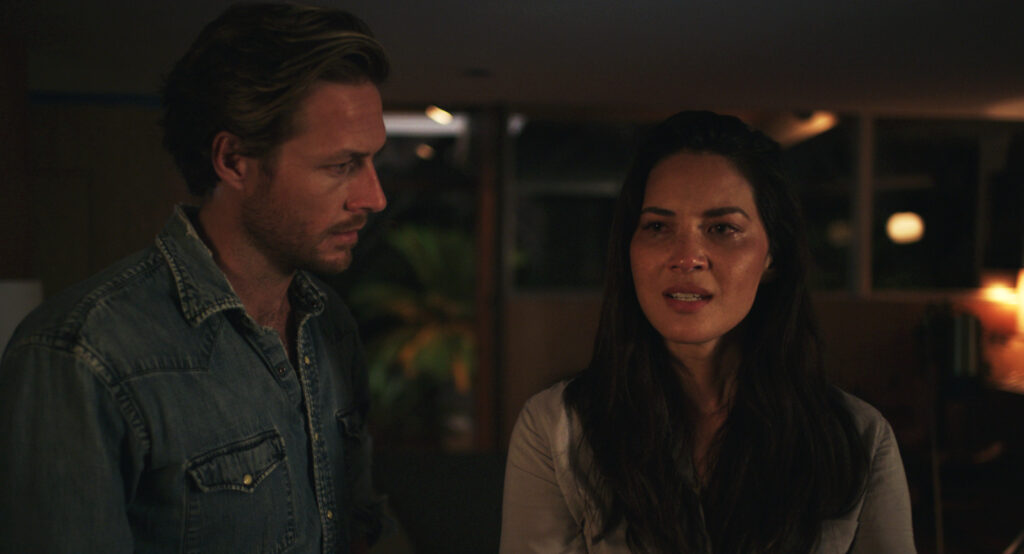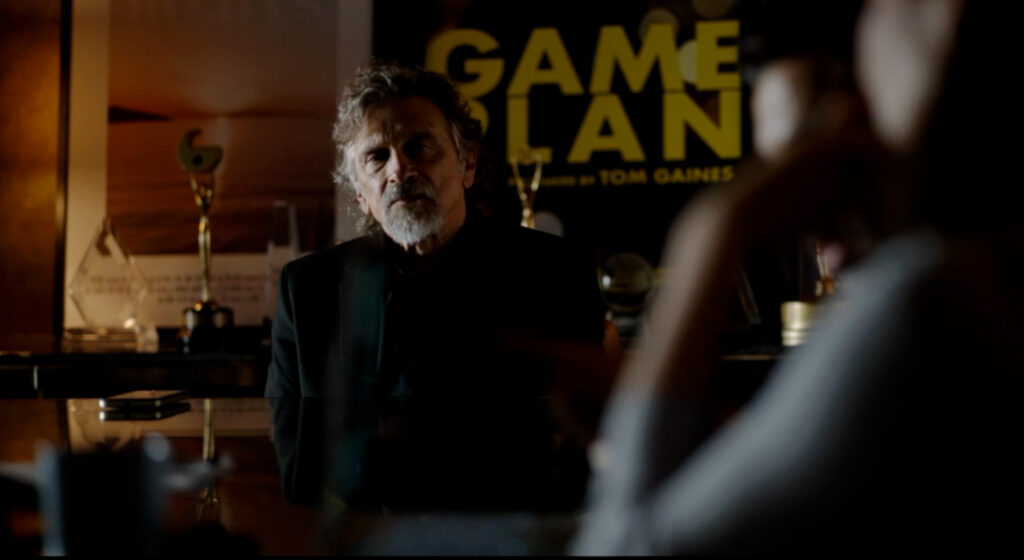March 8, 2022
by Carla Hay

Directed by Justine Bateman
Culture Representation: Taking place in the Los Angeles area, the dramatic film “Violet” features a predominantly white cast of characters (with a few Asians, African Americans and Latinos) representing the working-class and middle-class.
Culture Clash: A woman who’s the head of production at an independent film production company is wracked with insecurities about herself and is haunted by her troubled past with her estranged mother.
Culture Audience: “Violet” will appeal primarily to people who are interested in seeing a psychologically driven movie that shows a constant flow of a neurotic person’s conflicting thoughts.

“Violet” is a multilayered movie that effectively shows three psychological layers of an insecure person: the conscious mind, the subconscious mind, and how the person acts on any conflicts between the conscious and subconscious. Oliva Munn gives a riveting performance as the movie’s title character: a 32-year-old woman who is very uneasy with herself, but who tries to project to the outside world that she’s happy and confident. “Violet” (written and directed by Justine Bateman) is intended to make viewers uncomfortable because of how candidly and realistically it portrays people who seem to be one way in public but are quite another way in their deepest thoughts.
On the surface, Violet Calder (played by Munn) seems to have the kind of life that a lot of people want: She works in the movie industry in the Los Angeles area, where she’s head of production at an independent film production company called Gaines Pictures. But from the movie’s opening scene, viewers see that Violet is in fact discontented with her life because she’s very unhappy with herself. She’s the very definition of someone who has “imposter syndrome”—feeling like a fraud who’s unworthy of accomplishments and praise.
Throughout the movie, viewers see and hear two types of Violet’s inner thoughts. Her true feelings (her conscious mind), which are often vulnerable but optimistic, are shown in hand-written scrawls on screen. Her negative and self-critical side, which lies deep in her subconscious, can be heard in voiceovers by actor Justin Theroux. These warring thoughts often make statements that are in direct contrast to each other. The way that Violet reacts to these thoughts shows her decision making in what she ultimately does for her actions and words that she wants people to see as representing herself.
In the beginning of the movie, Violet is temporarily living at the house of her longtime friend Red (played by Luke Bracey), whom she has known since they were 12 years old. Violet and Red are both single with no children. The movie’s opening scene shows Violet in her car before she heads off to work. A hand-written scrawl appears on screen with these words: “Is there something wrong with me?” The negative voice can then be heard saying, “You’re a pig,” and begins to berate her by saying that people will think she’s a loser for not having her own place.
At her job, Violet has a few subordinates who don’t treat her like a boss they respect. They treat her more like someone to take advantage of by slacking off on their workload. Gaines Pictures’ headquarters has an open-floor plan, where Violet doesn’t have her own office. She has a desk that is right in the middle of the desks of people who have lower rankings at the company. These desks are placed classroom-style, while Gaines Pictures founder Tom Gaines (played by Dennis Boutsikaris), a longtime director/producer, has his own office. This company’s work space is a reflection of the company’s power structure and how Tom runs the company.
There are obvious signs that Violet is underappreciated and disrespected on the job. A subordinate named Bradley (played by Zachary Gordon) calls her “sugar plum” and asks her for production reports that he should already have. Brad and another subordinate named Julie (played by Cassandra Cardenes), who are both in their 20s, waste time by standing near Violet’s desk and distracting her with petty gossip instead of being responsible and doing their work.
The disrespect is even worse from her boss Tom, who is a misogynistic creep. During a conference room meeting with an outside colleague named Darren Brightly (played by Al Madrigal), Tom demeans Violet by making sexual innuendos that imply that she’s in a sexual relationship with Tom, and that she uses sex to get what she wants. Violet looks humiliated, while Darren looks like he’s too much in shock to say anything.
One person at Violet’s job who really seems to respect her is an administrative assistant named Keith (played by Keith Powers), who gripes to Violet about Brad and Julie: “They’re always saying stuff, and you just let them? You’re head of production. They work for you. They’re always over here bothering you. Why don’t you just tell them to fuck off?”
Violet replies, “Listen, it’s just better for me not to say anything. The less opportunity I give them to label me a ‘bitch,’ the better.” Meanwhile, the negative voice inside Violet’s head tells her that she should ignore the disrespect and micro-aggressions from her work colleagues. For example, in reaction to Bradley’s condescending attitude to Violet (even though she’s his boss), the negative voice tells Violet: “Let it go, or he’ll quit. Don’t be bossy.”
Throughout the course of the movie, Violet is shown making compromises that make her uncomfortable because she doesn’t want to be accused of being difficult. Other times, she lets the negative voice in her head get to her, and she acts very mean-spirited and selfish. Viewers often have to guess what Violet will do when the conscious and subconscious thoughts are completely opposite.
In addition to her boss and colleagues, there are other people in Violet’s life who see various sides of her. How much they take the time to know the real Violet is a reflection of how much they care about her. Red is a loyal and supportive friend, who tells Violet that she can talk to him about anything at any time. He seems to know she’s got a lot of inner turmoil that she finds difficult to disclose.
Violet has another close friend named Lila (played by Erica Ash), who thinks that Violet and Red should be a couple. However, Red is a screenwriter, and Violet thinks dating a writer would be a “step down” for her, so Violet tells Lila that she wants to continue to date executives in the entertainment industry. But based on Violet’s unhappy and unfulfilled love life, that decision isn’t working out so well for her.
To show a contrast between Violet’s self-esteem and Lila’s self-esteem, the movie has a scene where the two friends meet at a restaurant/bar for dinner and drinks. Violet says that she has her own “naysayer committee” in her head, and she tells Lila that she has to learn to stop listening to this inner negativity. Lila says she sometimes has self-doubt too, but her parents raised her to believe that she’s great, and anyone who says otherwise is lying. Violet definitely did not have that type of upbringing, so it’s yet another reason for Violet to feel insecure about herself. It also makes Violet envious of Lila’s genuine self-confidence.
Violet has some brief encounters with some other people during her emotional and psychological journey in this movie. In a parking lot, she randomly sees an ex-boyfriend named Martin (played by Simon Quarterman), a music executive who currently lives in New York City, but who’s visiting Los Angeles for work-related reasons. When Violet sees Martin again, it triggers painful memories of why Violet and Mike broke up. Viewers find out why in flashback scenes.
The movie’s flashbacks also include scenes of 8-year-old Violet (played by Liliana Mijangos) riding her bicycle, sometimes alone, sometimes with friends. These childhood flashbacks are often shown on a giant video screen, as if it’s replaying inside Violet’s head, and her inner voice tells her this childhood experience of riding a bike was the last time she truly felt freedom. But in one of those flashback scenes, Violet rides home on her bike, only to get a barrage of shouted insults and criticisms by her mother (who’s never seen on camera, but who is voiced by Erin Cantelo) as soon as Violet arrives at the front door.
You don’t have to be a psychiatrist to see that Violet’s fractured relationship with her abusive mother is the root cause of most of Violet’s self-esteem problems. Through conversations, it’s eventually revealed that Violet, whose closest family members live thousands of miles away in an unnamed U.S. state, has not spoken to her widow mother for the past three years. Violet’s older brother Rick (played by Todd Stashwick) and Violet’s maternal aunt Helen (played by Bonnie Bedelia) express resentment and hostility to Violet because she’s distanced herself from the family. They think Violet is too caught up in her Hollywood movie job and showbiz lifestyle to care about them.
“Violet” will probably have extra appeal to people who like seeing movies that authentically depict behind-the-scenes Hollywood production workers, what their jobs entail and the types of social events they go to outside of work. Getting a job in the movie industry can really come down to who you know and being in the right place at the right time, not having a college degree or lots of experience. For example, at a party, Violet is offered a job on the spot by two movie executives she knows named Dennis (played by Jim O’Heir) and Harry White (played by Jason Dohring), who have co-founded a new independent production company called Phoenix Circle Films. The movie shows whether or not she takes this job offer.
An example of why Violet feels like a failure is how her plans have stalled to make a movie out of a poetry book that she loves called “Fox Run.” The “Fox Run” movie was a pet project of Violet’s, and even had a screenplay, but the project has been stuck in “development hell.” Violet has pretty much given up on the movie ever getting made. Her obnoxious boss Tom comments to her about the “Fox Run” movie in front of her co-workers: “You were always a pussy for art films.”
Bradley and Tom know how much “Fox Run” means to Violet, so these toxic male colleagues both use that information to try to embarrass her in passive-aggressive ways. The “Fox Run” movie is obviously symbolic of how Violet feels about herself and how she’s treated by others: misunderstood, unappreciated and stuck in a rut. The “Fox Trot” movie is such a sore subject for Violet, when Lila asks Violet about the movie, Violet loses her temper and snaps, “Just drop it! It’s none of your fucking business!”
All of the cast members of “Violet” give credible performances, but how people respond to this movie mostly depends on how realistic they think Munn is in embodying this complicated character. It’s not about Violet being “likable.” It’s about her being believable.
“Violet” writer/director Bateman impressively uses techniques to show that Violet’s life sometimes plays like a movie in her head. In addition to the childhood flashbacks shown on a giant projector screen, other flashbacks are revealed as compelling quick-cut edits. Whenever the negative voice thoughts overwhelm Violet, the cinematography turns the screen a crimson red, with an effect simulating people fading out of vision and a monotone electronic noise drowning out the sound.
What “Violet” also does well is show how women in the workplace have to navigate differently than men, because women are more likely to have the threat of sexual harassment or the hassle of sexist people who automatically think the female gender is inferior to the male gender. “Violet” also poignantly shows how an abusive childhood can have long-lasting effects well into adulthood. It’s not always a pleasant film to watch, and the constant “war of words” in Violet’s head might be a turnoff to some viewers, but it’s hard not to be curious about how this psychological drama is going to end.
Relativity Media released “Violet” in select U.S. cinemas on October 29, 2021, with an expansion to more U.S. cinemas on November 5, 2021. The movie was released on digital and VOD on November 9, 2021.
